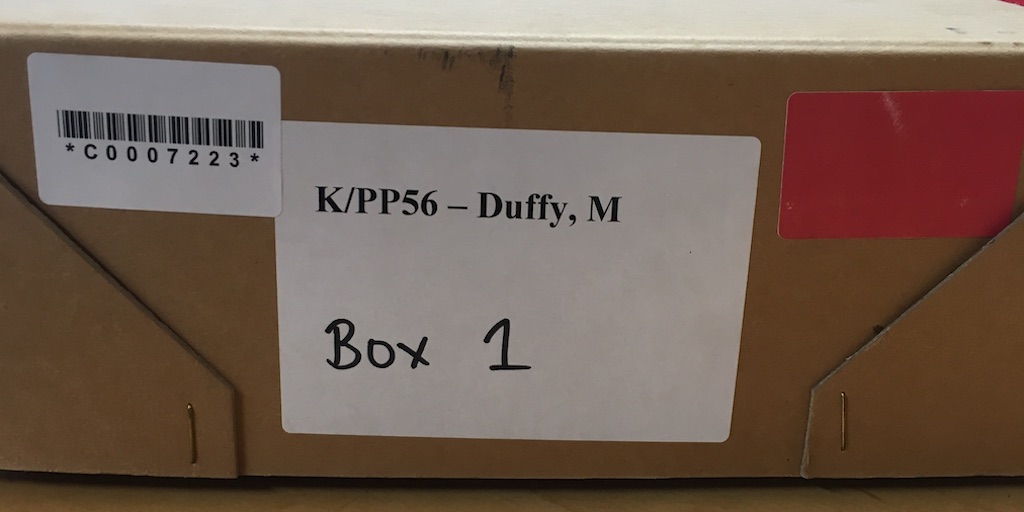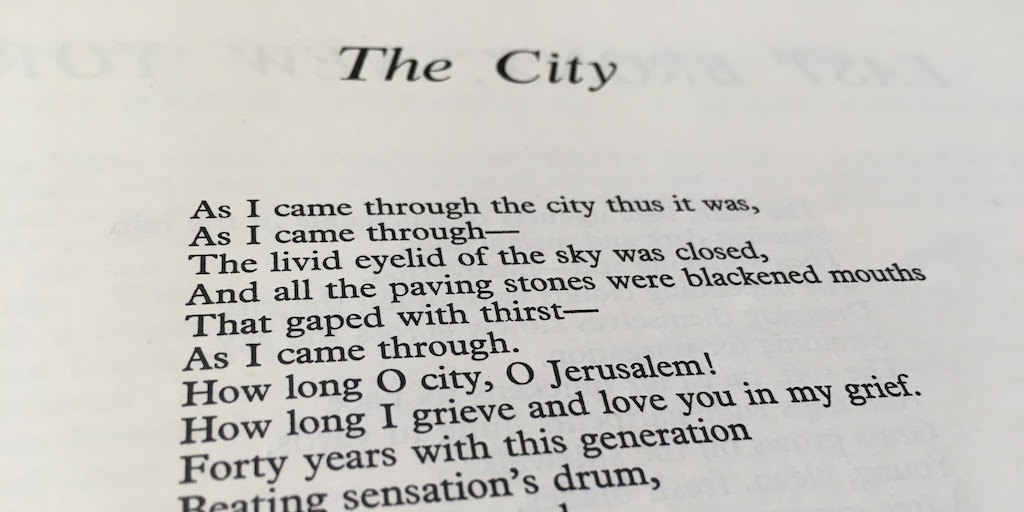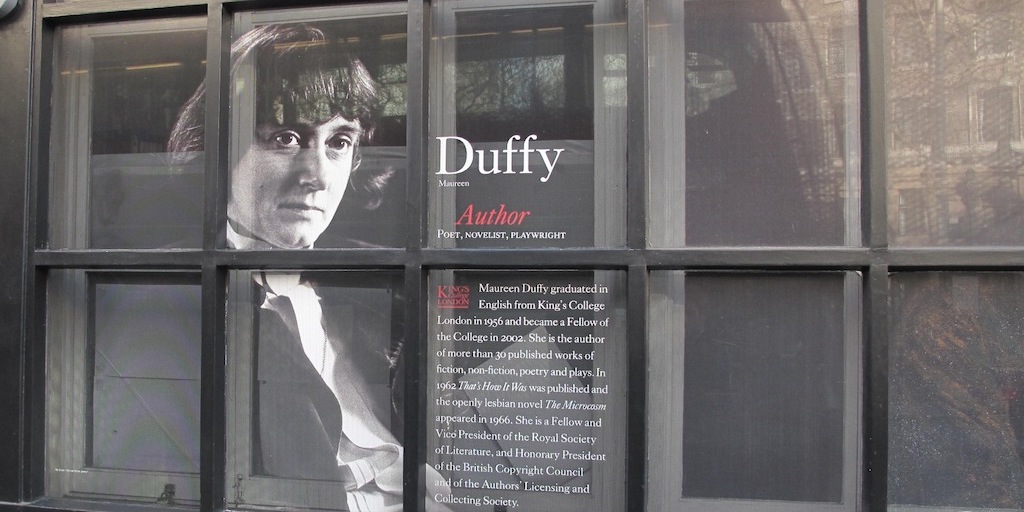Maureen Duffy at 80: In Times Like These
DUFFY AND KING'S
Header image: Maureen Duffy depicted in the windows of the King's Strand Campus © Christine Ayre
A Window for Maureen Duffy
by Clare Brant
One of the more imaginative ideas for corporate art has been the biographical windows along the Strand frontage of King’s. They celebrate distinguished alumni with a portrait of some sort and a few lines about their achievements.
Though obviously they have an agenda in promoting King’s as a place that produces famous and worthy people, and reflecting social diversity of race, ethnicity, age and gender, there is something refreshing about reading of discoveries and genius alongside the roaring traffic. Scientists, archbishops, writers, advocates – here they are among us. Anything is possible.
When a group of us thought about celebrating Maureen Duffy, it occurred to me that a window would be a fine tribute. Why not put her among the visible luminaries on the Strand? We had agreed to organise a day conference with scholars, readers and poets talking about why Maureen’s writing was important and distinctive, and why she mattered as a writer. There were also activist colleagues who came to speak about Maureen’s leadership, tenacity and vision on behalf of authors. That was well and good, but when such days are over there is little evidence of the concentrated energy of thought and feeling that inspires them. A window would be tangible and lasting.
It wasn’t immediately easy. First there was the request, and a case to be made. To my surprise there was a question of money; happily that was eventually overcome.
Then there was the question of where, and who would have to be removed to make way. I regretted any luminary being deposed – it was like excommunicating a saint – but somebody had to step down. The axe fell upon a Victorian seismologist, John Milne, who had invented a horizontal seismograph able to detect different types of earthquake waves and estimate their velocities. He was also a fan of Japan and an anthropologist who had identified a prehistoric people in North Japan. For several weeks I felt guilty about him.
The next question was what should be said about Maureen Duffy’s extraordinary output, covering poetry, novels, plays, memoirs, biographies? And her activism, for copyright and authors’ rights? And her boldness in so many genres? Her range of his ideas was bigger than a mere window could convey. Samuel Johnson wrote about epitaphs that their composition involved skill, because one had to say something about the person, something about death, and all in a short space. I came to respect the art of composing window text even more.
A form of words was settled on, and a photograph procured in the right head-and-shoulders format from the portrait held by the National Portrait Gallery, acquired in 1980. It was taken in 1973 by Fay Godwin who specialised in photographing writers. Unexpectedly the NPG catalogue entry tags the image under a theme of chairs, and indeed Maureen sits upon a fine chair of which one can see just the sweep of its top, in black, like a nun’s wimple. Like a modern silhouette too: hence timeless.
I was pleased. The proofs looked good, suitably authoritative, suitably authorial. They went off to be incised. Installation would have made a nice event: I imagined ribbon-cutting, cheers, a speech - I now declare this window open – like the topping off ceremony for a medieval cathedral. In the event it went up pragmatically and unsung. But suddenly it was there. When I first saw it I was startled – one could not have imagined how aggrandising the increase of scale became, and how in fitting in to a sequence it stood out. I was especially pleased to see the word lesbian on the Strand and right by the bus stop too.
It transpired that Maureen was pleased by the window: she was now in the company of John Keats and Virginia Woolf! It was one of the aims of 'Duffy Day', as I called it, to demonstrate emphatically that Maureen Duffy is one of the most significant writers in English literature, so yes, Keats and Woolf are fitting company.

Maureen Duffy depicted in the windows of the King's Strand Campus © Christine Ayre
When the English Department and others were moved from the Strand to Kingsway, college branding took up the dull hoardings of the hastily-renamed Virginia Woolf building to install a second biographical set, this time not on glass. That lost the beautiful capacity of the window to itself be something reflective, catching the sky and mirroring beyond as it does in Christine Ayre’s photograph. But it meant I could salute Maureen’s image, now set on a white background, on my new and otherwise ugly route to work. And perhaps the brutalism of Kingsway is as appropriate as the classicism of the Strand: Maureen’s writings take up difficult things too.
After a while of admiring the windows, it occurred to me that one other way to preserve Duffy Day was through Strandlines. Without funding, Strandlines was sadly quiet, gathering moss, even rusting. Curation of the day in digital form would be a way to share the day beyond its immediate participants, and provide a different sort of window on Maureen’s work, thanks to Windows. Katie Webb took on the challenge and here we are, no thanks to the people who managed to lose all the filmed footage of the day’s events. Literary critics talk of frames of reading: in glass and in e-reading, Maureen Duffy’s many achievements can shine through this digital window as luminously and numinously as they do through her glass window on the Strand.
With thanks to Katie Webb, Christine Kenyon-Jones (the window’s script artist), Clare Lees, John Stokes, Max Saunders, Patricia Methven, Charles Lock and all those who made Duffy Day a pleasure and an honouring.
Sections and Chapters
Duffy and King's introduction
Katie Webb
Finding Maureen Duffy in the Archives
Patricia Methven
King's in Maureen Duffy's time
Christine Kenyon Jones
Kings, and Queens, Histories in Fact and Fiction
Clare A. Lees
Panel Summary: the city as a space for new possibilities
Phoebe Blatton
Writing, Rites, and Rights
John Stokes
A Window for Maureen Duffy
Clare Brant
Fighting and Writing introduction
Katie Webb
Duffy and the European Writers' Congress
Lore Schultz-Wild
An 80th Birthday Honorific Speech
Ingrid Protze
Memories of the German Writers' Union
Sabine Herholz
On Maureen
Katalin Budai
A copyright warrior and a true defender of rights
Olav Stokkmo
Recognising writers: responses, records, royalties
Katie Webb
Maureen Duffy's contribution to gay rights and lesbian visibility
Jill Gardiner
For Maureen Duffy, Poiêtes
Karen Gevirtz
Editor's introduction
Katie Webb
Maureen Duffy: Scrivener and Prophet
Charles Lock
Words that count: Maureen Duffy
Marina Warner
Browse articles on Duffy and King's






